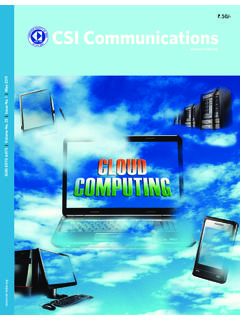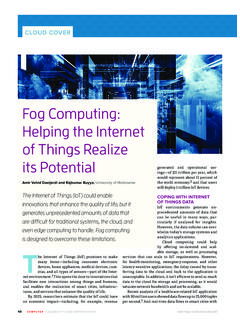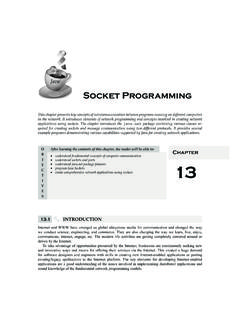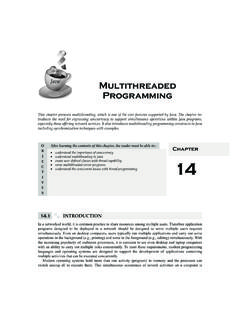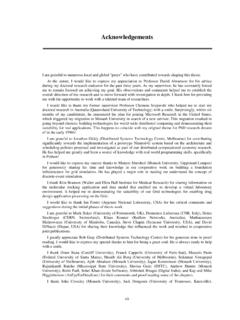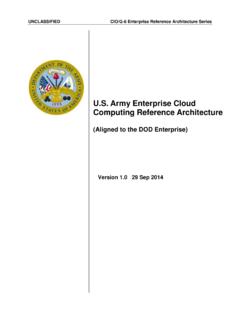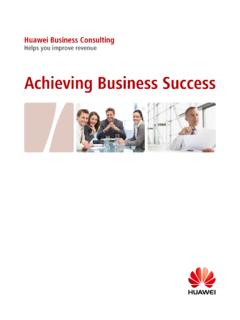Transcription of CloudSim:atoolkitformodelingandsimulationofcloud ...
1 SOFTWARE PRACTICE AND EXPERIENCES oftw. Pract. ;41:23 50 Published online 24 August 2010 in Wiley Online Library ( ). DOI: : a toolkit for modeling and simulation of cloudcomputing environments and evaluation of resourceprovisioning algorithmsRodrigo N. Calheiros1, Rajiv Ranjan2, Anton Beloglazov1,C esar A. F. De Rose3and Rajkumar Buyya1, , 1 cloud Computing and Distributed Systems(CLOUDS)Laboratory,Department of Computer Science and SoftwareEngineering,The University of Melbourne,Australia2 School of Computer Science and Engineering,The University of New South Wales,Sydney,Australia3 Department of Computer Science,Pontifical Catholic University of Rio Grande do Sul,Porto Alegre,BrazilSUMMARYC loud computing is a recent advancement wherein IT infrastructure and applications are provided as services to end-users under a usage-based payment model.
2 It can leverage virtualized services even on thefly based on requirements (workload patterns and QoS) varying with time. The application services hostedunder cloud computing model have complex provisioning, composition, configuration, and deploymentrequirements. Evaluating the performance of cloud provisioning policies, application workload models,and resources performance models in a repeatable manner under varying system and user configurationsand requirements is difficult to achieve. To overcome this challenge, we propose cloudsim : an extensiblesimulation toolkit that enables modeling and simulation of cloud computing systems and applicationprovisioning environments.
3 The cloudsim toolkit supports both system and behavior modeling of Cloudsystem components such as data centers, virtual machines (VMs) and resource provisioning implements generic application provisioning techniques that can be extended with ease and limitedeffort. Currently, it supports modeling and simulation of cloud computing environments consisting ofboth single and inter-networked clouds (federation of clouds). Moreover, it exposes custom interfaces forimplementing policies and provisioning techniques for allocation of VMs under inter-networked Cloudcomputing scenarios. Several researchers from organizations, such as HP Labs in , are usingCloudSim in their investigation on cloud resource provisioning and energy-efficient management ofdata center resources.
4 The usefulness of cloudsim is demonstrated by a case study involving dynamicprovisioning of application services in the hybrid federated clouds environment. The result of this case studyproves that the federated cloud computing model significantly improves the application QoS requirementsunder fluctuating resource and service demand patterns. Copyrightq2010 John Wiley & Sons, 3 November 2009; Revised 4 June 2010; Accepted 14 June 2010 KEY WORDS: cloud computing; modelling and simulation; performance evaluation; resource manage-ment; application scheduling1. INTRODUCTIONC loud computing delivers infrastructure, platform, and software that are made available assubscription-based services in a pay-as-you-go model to consumers.
5 These services are referredto as Infrastructure as a Service (IaaS), Platform as a Service (PaaS), and Software as a Service(SaaS) in industries. The importance of these services was highlighted in a recent report from theUniversity of Berkeley as: cloud computing, the long-held dream of computing as a utility has Correspondence to: Rajkumar Buyya, cloud Computing and Distributed Systems (CLOUDS) Laboratory, Departmentof Computer Science and Software Engineering, The University of Melbourne, Australia. E-mail: John Wiley & Sons, N. CALHEIROSET potential to transform a large part of the IT industry, making software even more attractive asa service [1].
6 Clouds[2]aim to power the next-generation data centers as the enabling platform for dynamicand flexible application provisioning. This is facilitated by exposing data center s capabilities as anetwork of virtual services ( hardware, database, user-interface, and application logic) so thatusers are able to access and deploy applications from anywhere in the Internet driven by the demandand Quality of Service (QoS) requirements[3]. Similarly, IT companies with innovative ideas fornew application services are no longer required to make large capital outlays in the hardware andsoftware infrastructures. By using clouds as the application hosting platform, IT companies arefreed from the trivial task of setting up basic hardware and software infrastructures.
7 Thus, theycan focus more on innovation and creation of business values for their application services[1].Some of the traditional and emerging cloud -based application services include social networking,web hosting, content delivery, and real-time instrumented data processing. Each of these appli-cation types has different composition, configuration, and deployment requirements. Quantifyingthe performance of provisioning (scheduling and allocation) policies in a real cloud computingenvironment (Amazon EC2[4], Microsoft Azure[5], Google App Engine[6]) for different appli-cation models under transient conditions is extremely challenging because: (i) Clouds exhibitvarying demands, supply patterns, system sizes, and resources (hardware, software, network);(ii) users have heterogeneous, dynamic, and competing QoS requirements; and (iii) applicationshave varying performance, workload, and dynamic application scaling requirements.
8 The use ofreal infrastructures, such as Amazon EC2 and Microsoft Azure, for benchmarking the applicationperformance (throughput, cost benefits) under variable conditions (availability, workload patterns)is often constrained by the rigidity of the infrastructure. Hence, this makes the reproduction ofresults that can be relied upon, an extremely difficult undertaking. Further, it is tedious and time-consuming to re-configure benchmarking parameters across a massive-scale cloud computinginfrastructure over multiple test runs. Such limitations are caused by the conditions prevailing in theCloud-based environments that are not in the control of developers of application services.
9 Thus,it is not possible to perform benchmarking experiments in repeatable, dependable, and scalableenvironments using real-world cloud more viable alternative is the use of simulation tools. These tools open up the possibilityof evaluating the hypothesis (application benchmarking study) in a controlled environment whereone can easily reproduce results. Simulation-based approaches offer significant benefits to ITcompanies (or anyone who wants to offer his application services through clouds) by allowingthem to: (i) test their services in repeatable and controllable environment; (ii) tune the systembottlenecks before deploying on real clouds; and (iii) experiment with different workload mix andresource performance scenarios on simulated infrastructures for developing and testing adaptiveapplication provisioning techniques[7].
10 Considering that none of the current distributed (including Grid and Network) system simulators[8 10]offer the environment that can be directly used for modeling cloud computing environ-ments, we present cloudsim : a new, generalized, and extensible simulation framework that allowsseamless modeling, simulation, and experimentation of emerging cloud computing infrastructuresand application services. By using cloudsim , researchers and industry-based developers can testthe performance of a newly developed application service in a controlled and easy to set-up environ-ment. Based on the evaluation results reported by cloudsim , they can further finetune the serviceperformance.
